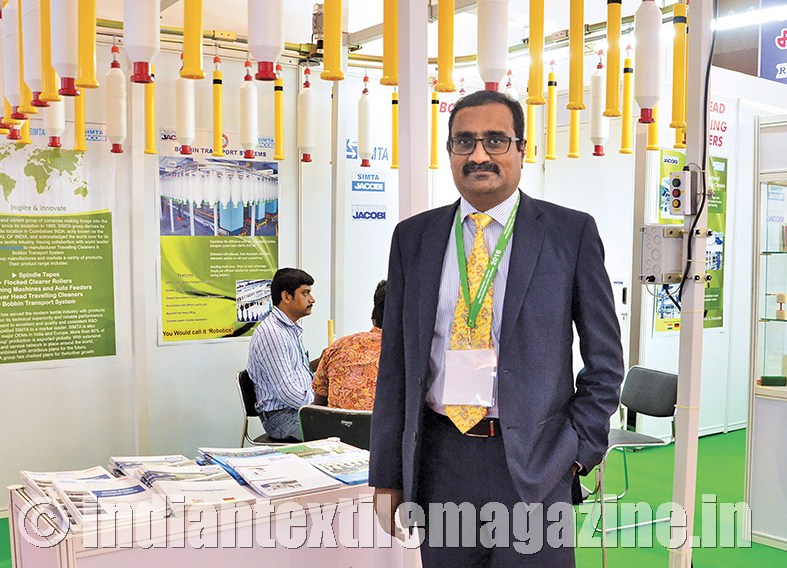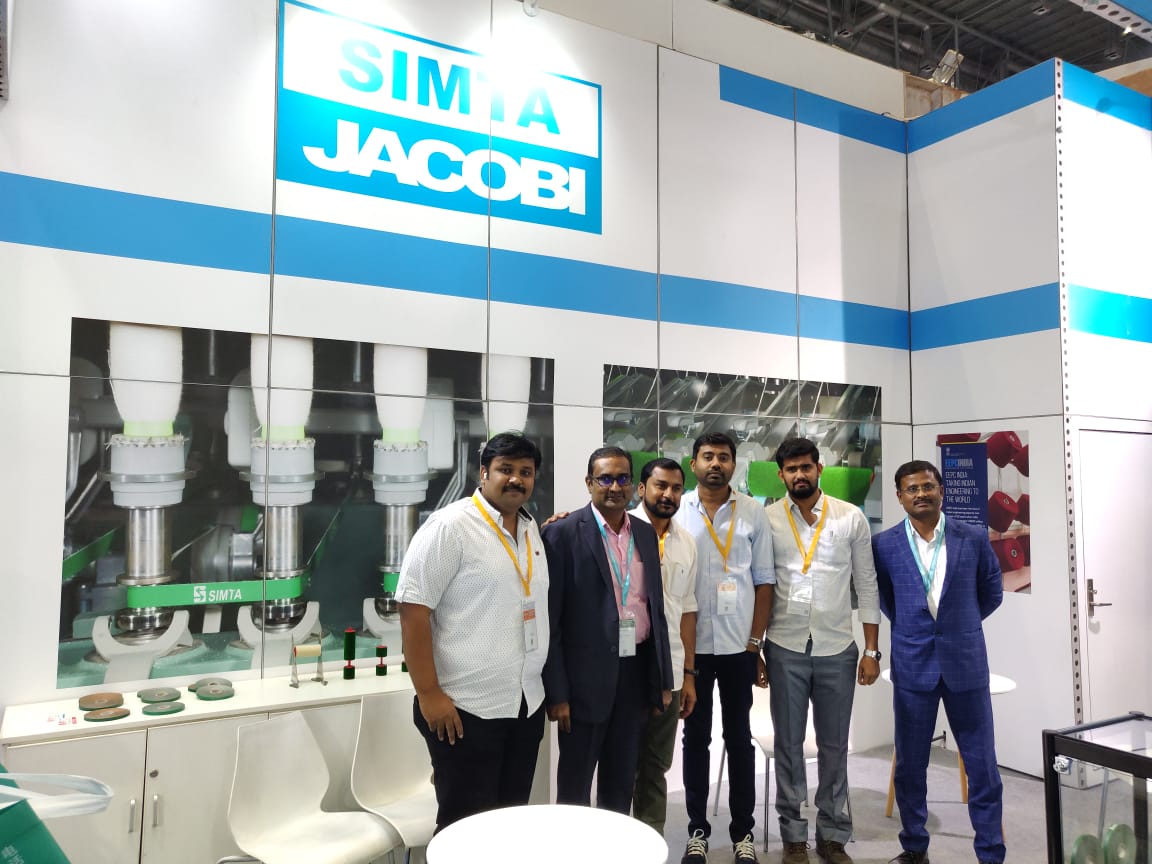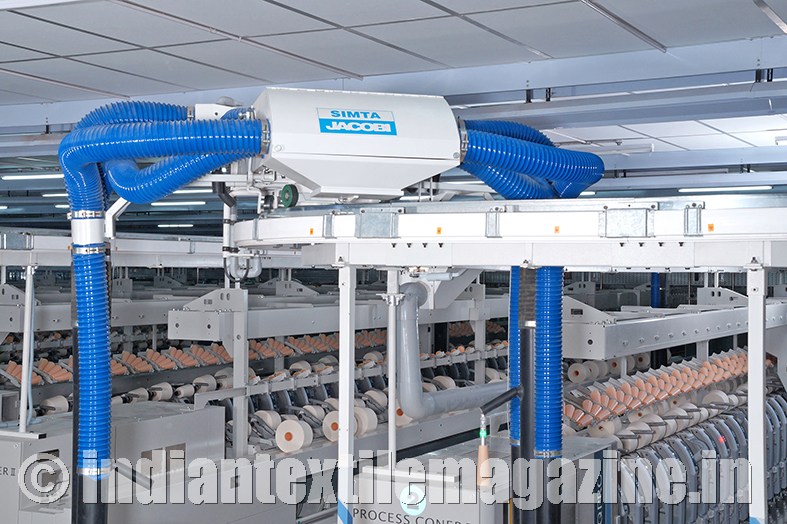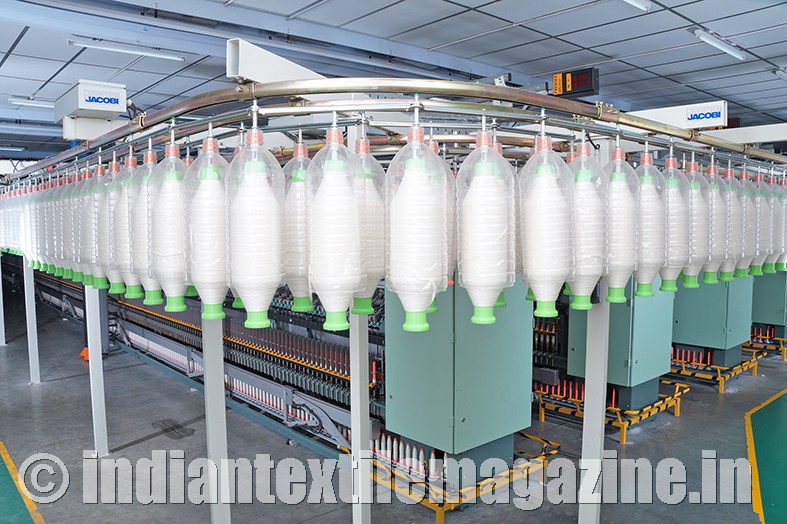Retains leadership in OHTC and BTS product segments
The SIMTA Group, with its range of quality products, including spindle tapes, overhead travelling cleaners (OHTCs), bobbin transport system (BTS) and clearer rollers with the cleaning machine, has carved a distinct identity for itself in some of the highly competitive market segments in the textile machinery industry.

Speaking exclusively to The Textile Magazine, Mr. Senthil Kumar, Managing Director of the group, looked back fondly at what has been indeed an eventful journey. “Our beginnings were quite modest. When we started in 1991, we had about 15-odd employees, a number which has grown to over 400 now. Over the last 27 years, our focus has been on offering quality products, backed up by excellent service. This approach has stood us in good stead through the ups and downs, as well as helped us successfully surmount various challenges”.
Sounding happy with the group’s recent performance, Mr. Senthil Kumar said: “FY 2017-18 was good for us, in the sense that we were able to achieve our targets. We are optimistic about the current year also, as our performance till now has been better than the corresponding period last year. There has been a 15-20% growth”.
Growth in demand
“We have seen growth in the OHTC and BTS products segments, and we have been able to make inroads into new markets like Turkey, the Middle East, Indonesia, Thailand, etc. Along with exports, the other exciting news is the rising domestic demand. Issues such as labour shortage are driving forward the growth of our kind of products,” Mr. Senthil Kumar disclosed.
The partnership between SIMTA and Jacobi for manufacturing OHTCs and BTS has been one of the most enduring ones in the industry, spanning across 18 years.
He added: “We have started a 50:50 joint venture with them, namely, Jacobi Machinery Pvt. Ltd., which supplies BTS globally. We now cater to the global requirement of Jacobi from the facility in Coimbatore. They continue to have the R&D center though, as well as taking care of the marketing in certain geographical areas such as Pakistan, Turkey, Egypt, Syria, etc. It is a relationship that has now grown even stronger”.
While the share of exports versus domestic consumption was 70:30, this year it is close to 50:50, with domestic demand picking up fast.
Elaborating on the reasons that make the company’s products such as its OHTCs and BTS prominent, Mr. Senthil Kumar pointed out: “We want the spares consumption in our OHTCs to be very less. We want to make it around 50% lower than our competition. Currently it is at around 35%. Plus, we are very particular about product quality”. The company boasts of a service team of 30 technicians spread across the country.
Successful diversification
Apart from its textile products, the group has also diversified successfully into other product domains too in the recent past. It has, for example, emerged as one of the top players supplying UPVSC profiles. Explaining this foray, Mr. Senthil Kumar said: “We were sourcing UPVSC-based power ducts in our OHTCs from others. We were not satisfied with the quality standards. So we thought of not manufacturing the parts ourselves. Then we saw that the machine that we were using for manufacturing the power ducts was being used only for about 5 days in a month. That is when we hit upon the idea of venturing into this product segment, with what the country is perhaps in the midst of its biggest building boom”.
The company has also started manufacturing multi-level car parking systems. “if you look at it, the concept is very similar to BTS, i.e., transporting something from point ‘A’ to point ‘B’, though the scale is much bigger. We have already completed two projects successfully and continue to witness the growth in the segment”, Mr. Senthil Kumar explained.
So, what is the percentage of textile-related products in the group’s overall product portfolio? Answering this question, Mr. Senthil mentioned: “Textiles continue to be a significant 50% of our portfolio, although I should admit here that there is stiff competition from the other product domains, for the demand in those fields is growing exponentially. This has in fact given us a way to motivate our team involved in textiles. Now, they need to buck up and reach higher target levels to keep up with the other divisions. The fact that we have recently expanded our sales personnel as well as appointed an export manager is a clear indication that the textile machinery vertical continues to be crucial for us”.
Value for money proposition
The company which is known for its consistent innovation is also pilot-testing other products such as a cop sorting machine as well as providing automation solutions, such as cone automation, and is expected to announce new launches in these areas soon.
The SIMTA Group, which has got five manufacturing units spread across the Coimbatore region, is also making a foray into the Industry 4.0 domain, incorporating features in its BTS. “Customers can now get valuable data about aspects such as the number of doffs used, bobbins transported and those hung, etc., it is only when the simplex gets converted into yarn that it is business for the customer. So, we offer technology that provides data from the BTS to the MIS, so that it helps the customer improve his productivity”.
By M.K. Prabhakar & Mohan Raj


